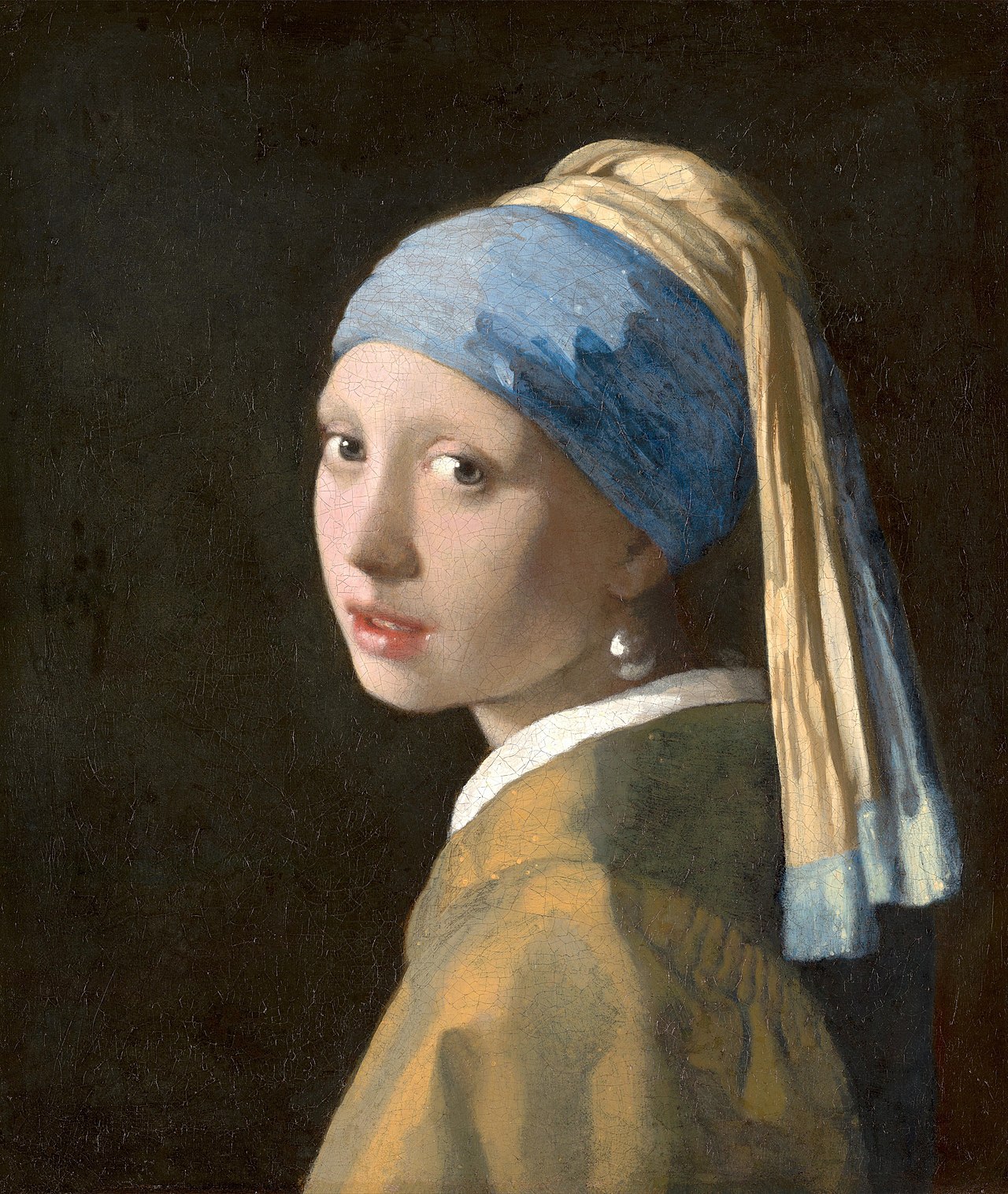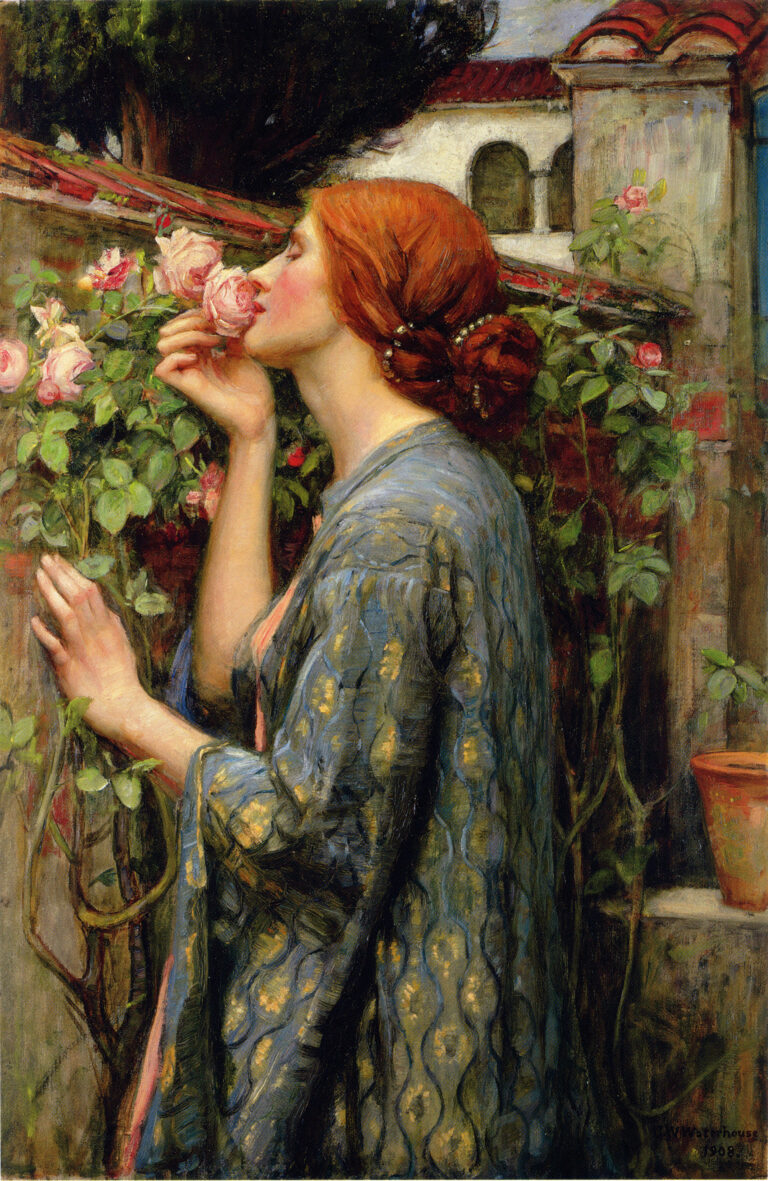
“Girl with a Pearl Earring” is a 17th-century oil painting by the Dutch painter Johannes Vermeer. It depicts a young woman wearing a blue and gold turban and a large pearl earring.
The composition of the painting is relatively simple, with the woman’s face taking up most of the frame. She is positioned slightly off-centre, with her eyes looking directly at the viewer. The background is a dark grey-green, and there is a faint hint of light coming in from the left-hand side. Vermeer uses the technique of chiaroscuro to create a sense of depth in the painting. The use of light and dark shades is a classic technique that Vermeer used to create a sense of depth in the painting. The background of the painting is a dark, neutral colour, and this creates a contrast with the light, illuminated face of the girl. The use of chiaroscuro helps to create a sense of depth in the painting, and it also creates a sense of mystery. The girl’s gaze is also symbolic in the painting. The girl’s gaze is very direct, and it creates a sense of intimacy and connection with the viewer. The girl’s gaze is also a symbol of the girl’s strength and independence. The girl is not portrayed as a passive, submissive figure, but rather as a strong, independent woman.
“I try to exaggerate the truth, so that it will be more true.” – Johannes Vermeer
The use of colour in the painting is notable. The woman’s skin is rendered in a soft, warm tone that contrasts with the cool blues and greys of her clothing and the background. The blue of her turban is particularly striking, and the gold band around it adds a touch of warmth to the overall colour scheme. The pearl earring is also a bright, luminous white, standing out against the muted tones of the rest of the painting. The girl’s face is illuminated by a soft, diffused light that creates a sense of serenity and calmness. Vermeer uses a warm, golden colour to create the illumination on the girl’s face, and this creates a sense of warmth and comfort. The girl’s clothing is a deep blue colour, and this creates a sense of depth and richness in the painting. The deep blue colon of the girl’s clothing also creates a sense of calmness and serenity.
The symbolic meaning of the colours in “Girl with a Pearl Earring” is somewhat unclear, but there are a few theories. Blue was a popular colour in Dutch painting of the time, and was often associated with virtue and fidelity. The turban may also have been intended to suggest exoticism or the Orient. The gold band on the turban could be seen as a symbol of wealth and luxury. The pearl earring that the girl is wearing is a central focus of the painting, and Vermeer uses a very subtle, soft colour to create the pearl earring. The pearl earring is a very delicate, subtle colour that creates a sense of elegance and refinement. The pearl earring itself is a powerful symbol, representing purity, innocence, and wealth. Pearls were highly valued in the 17th century, and were often worn by wealthy women as a status symbol. The fact that the earring is worn by a young woman with an ambiguous expression has led some to speculate that it may also be a symbol of female sexuality.
The girl in the painting is positioned slightly off-centre, and this creates a sense of balance in the painting. Vermeer uses the girl’s gaze to draw the viewer’s attention to her face. The girl’s head is turned slightly to the side, and this creates a sense of movement in the painting. Vermeer also uses the girl’s clothing to create a sense of texture in the painting. The girl is wearing a turban-like headscarf, and this creates a sense of movement and texture.
Johannes Vermeer’s “Girl with a Pearl Earring” is a masterpiece of composition, use of colours, and symbolism. The composition of the painting creates a sense of balance and movement, and the use of chiaroscuro creates a sense of depth and mystery. The use of colours creates a sense of harmony and balance, and it also creates a sense of depth and richness. The use of symbolism in the painting is very subtle and sophisticated, and it adds to the overall beauty and elegance of the painting. Vermeer’s “Girl with a Pearl Earring” is a timeless work of art that will continue to captivate people for centuries to come.
The Baroque Era
The Baroque era was a period of European art, architecture, music, and culture that spanned the 17th and early 18th centuries, from approximately 1600 to 1750. The Baroque era is characterized by a grand, ornate style that was intended to inspire awe and wonder in the viewer or listener. This style is often associated with the Catholic Church, which was a major patron of Baroque art and music, but it was also used in secular contexts, such as in the courts of monarchs and nobles.
Baroque art is characterized by dramatic, theatrical compositions, with strong contrasts of light and shadow, and a focus on emotional expression. Baroque architecture is characterized by grand, ornate structures with intricate details, including ornate sculptures and frescoes. Baroque music is characterized by grand, elaborate compositions with complex harmonies and instrumentation.
The Baroque era was a time of great cultural, political, and social change in Europe, marked by religious conflicts, scientific discoveries, and the rise of powerful monarchs. The art and culture of the Baroque era reflected this sense of drama and grandeur, and it continues to be celebrated and appreciated to this day.

